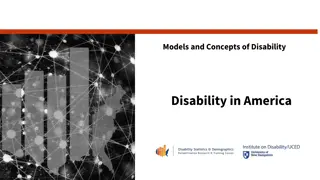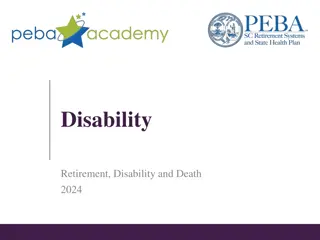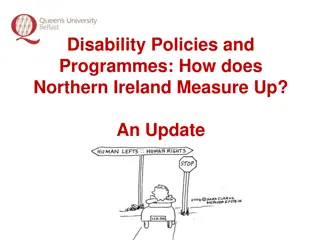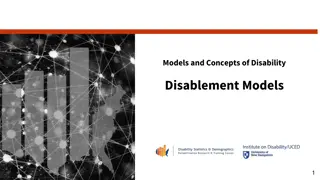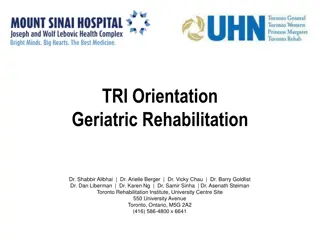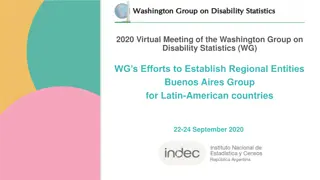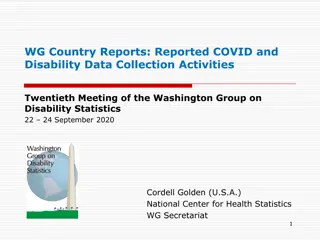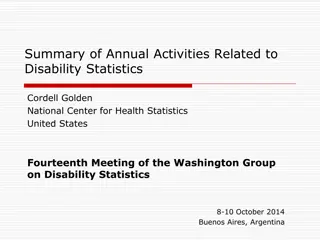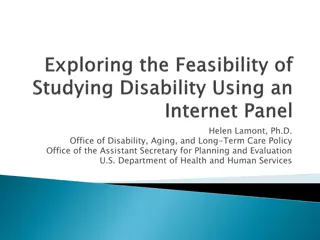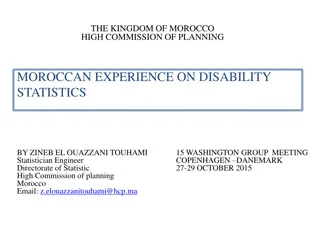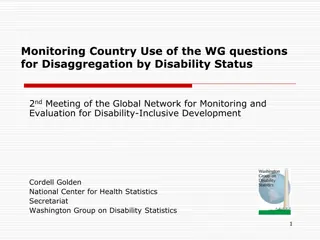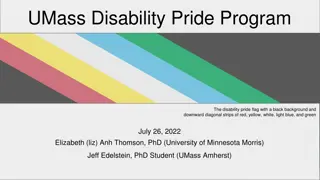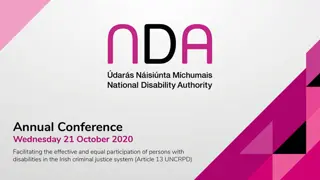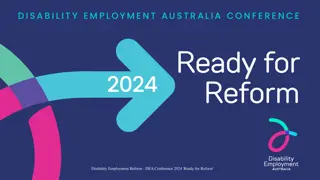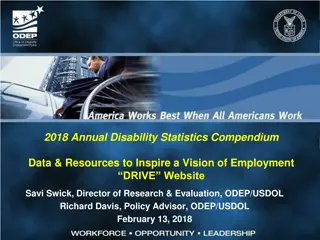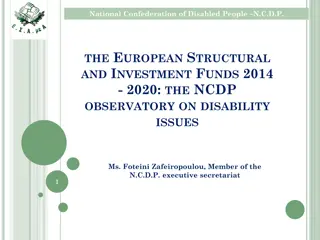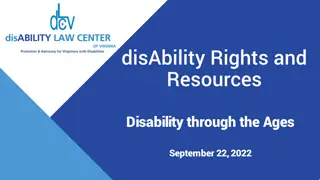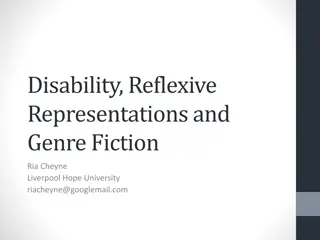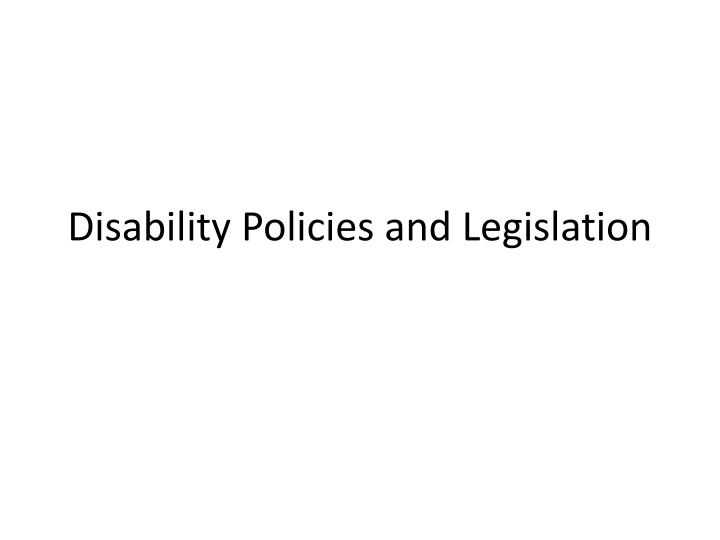
Disability Policies and Legislation Overview
The World Program of Action Concerning Disabled Persons (WPA) and the Standard Rules on the Equalization of Opportunities for PWDs aim to enhance disability prevention, rehabilitation, and equalization of opportunities. The UN Convention on the Rights of Persons with Disabilities (CRPD) articulates the rights of persons with disabilities, promoting respect for their inherent dignity and ensuring the full realization of their human rights. This comprehensive framework signifies a paradigm shift in addressing disabilities, emphasizing equal participation and rights realization.
Download Presentation

Please find below an Image/Link to download the presentation.
The content on the website is provided AS IS for your information and personal use only. It may not be sold, licensed, or shared on other websites without obtaining consent from the author. If you encounter any issues during the download, it is possible that the publisher has removed the file from their server.
You are allowed to download the files provided on this website for personal or commercial use, subject to the condition that they are used lawfully. All files are the property of their respective owners.
The content on the website is provided AS IS for your information and personal use only. It may not be sold, licensed, or shared on other websites without obtaining consent from the author.
E N D
Presentation Transcript
World Program of Action Concerning Disabled Persons (WPA) WPA is a global strategy to enhance disability prevention, rehabilitation, and equalization of opportunities. Early detection, diagnosis and intervention; medical care and treatment; social, psychological and other types of counselling and assistance; training in self-care activities, including mobility, communication and daily living skills, with special provisions as needed, e g., for the hearing impaired, the visually impaired and the mentally retarded; provision of technical and mobility aids and other devices; specialized education services; vocational rehabilitation services (including vocational guidance), vocational training, placement in open or sheltered employment; and follow-up. "Equalization of opportunities" is a central theme of the WPA and refers to the process through which the general system of society, such as the physical and cultural environment, housing and transportation, social and health services, educational and work opportunities, cultural and social life, including sports and recreational facilities, are made accessible to all.
The Standard Rules on the Equalization of Opportunities for PWDs Preconditions for equal participation: awareness-raising, medical care, rehabilitation and support services (rules 1- 4); target areas for equal participation: accessibility, education, employment, income maintenance and social security, family life and personal integrity, culture, recreation and sports, and religion (rules 5-12); implementation measures: information and research, policy-making and planning, legislation, economic policies, co-ordination of work, organisations of PWDs, personnel training, national monitoring and evaluation of disability programmes in the implementation of the Standard Rules, technical and economic co-operation, and international co- operation (rules 13-22).
UN CRPD The Convention is an international treaty that articulates the rights of persons with disabilities and has binding effect. States that become parties to the Convention agree to promote, protect and ensure the full and equal enjoyment of all human rights and fundamental freedoms by all persons with disabilities, and to promote respect for their inherent dignity.
UN CRPD (cont.) The Convention is comprehensive, and States parties are obliged to ensure and promote the full realization of all civil, cultural, economic, political and social rights of persons with disabilities. The Convention is a paradigm shift in approaches to disability, moving from a model where persons with disabilities are treated as objects of medical treatment, charity and social protection to a model where persons with disabilities are recognized as subjects of human rights.
UN CRPD (cont.) Though all of the international human rights treaties extend to persons with disabilities, this large group of persons continues to suffer from discrimination and often does not enjoy respect for their human rights on an equal basis with others. This Convention: Explicitly defines and applies existing human rights principles to persons with disabilities; Provides an authoritative, internationally agreed basis for the development of domestic law and policy; Establishes national and international mechanisms for more effective monitoring of the rights of persons with disabilities Recognizes the especially vulnerable circumstances of children and women with disabilities.
Principles of UN CRPD The principles of the Convention (as stated under article 3) are: Respect for inherent dignity, individual autonomy including the freedom to make one's own choices, and independence of persons; Non-discrimination; Full and effective participation and inclusion in society; Respect for difference and acceptance of persons with disabilities as part of human diversity and humanity; Equality of opportunity; Accessibility; Equality between men and women; Respect for the evolving capacities of children with disabilities and respect for the right of children with disabilities to preserve their identities.
Inclusive development Inclusive development is the design and effective implementation of public policies and actions that bring about socio-economic and human development, in a way that promotes the capacities and equal opportunities and rights of all people, regardless of their social condition, gender, age, physical or mental condition, ethnicity, religion, etc., in sustainable harmony with the environment.
Disability-inclusive development (DID) Disability-inclusive development (DID) sets out to achieve equality of human rights for PWDs as well as full participation in, and access to, all aspects of society. It actively seeks to ensure the full participation of people with disabilities as empowered self- advocates in all development processes and emergency responses and works to address the barriers which hinder their access and participation.
Core elements of DID Core elements of DID, through which we can include PWDs in a development effort, are: Participation Accessibility Universal Design Twin-track approach Awareness Empowerment
Participation A core principle of inclusive development is participation of all marginalized groups. The participation of PWDs in how society is governed, including the design and development of policies and infrastructures, is a core principle of disability-inclusive development and is also a core principle of the UN CRPD.
Accessibility Accessibility for persons with disabilities refers to having the same opportunities to premises, goods, and services as others through accommodation and assistive technology, and, most importantly, through the removing barriers and elimination of discriminatory practices. Thus, identifying and removing barriers is fundamental in ensuring accessibility. To enable persons with disabilities to live independently and participate fully in all aspects of life, States Parties shall take appropriate measures to ensure to persons with disabilities access, on an equal basis with others, to the physical environment, to transportation, to information and communications, including information and communications technologies and systems, and to other facilities and services open or provided to the public (UN CRPWD, art.9[1]).
Barriers Physical or environmental barriers - buildings, schools, clinics, water pumps, transport, roads, paths etc. Communication barriers - written and spoken information including media, flyers, internet, community meetings etc. Policy barriers - including both legislation that discriminates against people with disability, and/or an absence of legislation that might otherwise provide an enabling framework. Attitudinal barriers - including negative stereotyping of people with disability, social stigma and other forms of overt discrimination.
Dimensions of accessibility Based on the types of barriers, accessibility therefore has the following dimensions: Social/attitudinal accessibility: removing the stigma and other negative behavior against persons with disabilities and their families/caretakers Intellectual accessibility: providing reading formats and speaking in a way that is accessible to people with intellectual/learning impairments Communication accessibility: ensure accessible formats in alternative modes and means of communication.
Dimensions of accessibility (cont) Institutional accessibility: ensuring that legislation, policies and particularly practice do not contribute to the exclusion and discrimination of persons with disabilities. Physical accessibility: the removal of barriers in the physical environment Economic accessibility: also referred to as affordability , this aspect of accessibility has been established as part of the core requirements of social and economic rights
Universal Design Universal design is the design of products, environments, programms and services to be usable by all people, to the greatest extent possible, without the need for adaptation or specialized design. The intent of universal design is to simplify life for everyone by making products, communications, and the built environment more usable by as many people as possible at little or no extra cost.
Principle's of universal design 1. Equitable Use: The design does not disadvantage or stigmatize any group of users. 2. Flexibility in Use: The design accommodates a wide range of individual preferences and abilities. 3. Simple, Intuitive Use: Use of the design is easy to understand, regardless of the user s experience, knowledge, language skills, or current concentration level. 4. Perceptible Information: The design communicates necessary information effectively to the user, regardless of ambient conditions or the user s sensory abilities.
Principle's of universal design (cont) 5. Tolerance for Error: The design minimizes hazards and the adverse consequences of accidental or unintended actions. 6. Low Physical Effort: The design can be used efficiently and comfortably, and with a minimum of fatigue. 7. Size and Space for Approach and Use: Appropriate size and space are provided for approach, reach, manipulation, and use, regardless of the user s body size, posture, or mobility.
Twin-track approach The twin-track approach aims at mainstreaming disability into every sector and every development action as well as many develop programs/policies specifically target PWDs. The twin-track approach thus demands states to prepare Broad-spectrum general laws/policies that promote participation and rights of people in general including those with disabilities; and Laws/policies that are specifically designed for disabled people and groups.
UN SDGs and disability Out of 17 Goals, 13 are particularly related to persons with disabilities, but only 7 targets found in the following 5 goals have an explicit reference of PWDs. SDG 4: Guaranteeing equal and accessible education by building inclusive learning environments and providing assistance for PWDs SDG 8: Promoting inclusive economic growth, including full and productive employment allowing PWDs to access the job market
UN SDGs and disability (cont.) SDG 10: Emphasizing on reducing inequalities among and within countries, promotes the social, economic and political inclusion of PWDs SDG 11: Creating accessible cities and water resources, affordable and sustainable transportation systems, providing universal access to safe, inclusive, accessible and green public spaces SDG 17: Emphasizing the importance of data collection and monitoring of the disability-related SDGs
Special Schools Segregated/special schools Are special placements in which students with disabilities are removed to a separate school where they are no longer exposed to non-disabled students evolved as a separate system of education for disabled children outside the mainstream , based on the assumption that disabled children had needs which could not be addressed within mainstream schools are usually organized according to impairment categories, such as schools for blind or deaf children, for children with learning difficulties, behavior problems, physical and multiple impairments Concentrate in urban centers have resulted in separate cultures and identities of disabled people, and isolation from their homes and communities.
Integration Views of integration range from location of a special class in a regular school campus to the individual student as a full-time member of a regular class. In between, integration has also been used to describe as little as half a day a week in the regular class. integration may be also enrolment in a regular class, with perhaps minimum withdrawal for therapy or special instructional needs that cannot be met without difficulty or considerable disruption to the regular class.
Education for All Education for all (EFA), which means that every child, regardless of status, is entitled to an education. Every child has a fundamental right to an education, and schools should develop a child- centered philosophy to accommodate the needs of all children.
Inclusive Education According to the philosophy of inclusive education, schools should accommodate all children regardless of their physical, intellectual, social, emotional, linguistic or other conditions. This should include disabled and gifted children, street and working children, children from remote or nomadic populations, children from linguistic, ethnic or cultural minorities and children from other disadvantaged or marginalized areas or groups.
Inclusive Education (cont.) Inclusion requires the restructuring of the physical environment, the broadening of instructional strategies and curricula, and changes in the social and psychological attitudes of teachers, administrators, and students.
Justifications for Inclusive Education Educational justification: the requirement for inclusive schools to educate all children together means that they have to develop ways of teaching that respond to individual differences and thus benefit all children. social justification: inclusive schools are able to change attitudes to difference by educating all children together and form the basis for a just and non-discriminatory society. economic justification: it is likely to be less costly to establish and maintain schools which educate all children together than to set up a complex system of different types of school specializing in different groups of children.
A Continuum Model A continuum model, under which school districts must have available a range of educational options so that students can receive the most appropriate educational program. Then, parents and school districts can choose a segregated or integrated option depending on what is more appropriate for an individual child. The appropriate educational environment should be considered on an individual basis without a presumption in favor of or against integration.
Employment Policies Non-Discrimination laws and quota schemes are the two most frequent policies found in the legislation of many countries in ensuring the right of PWDs to employment. Other employment related policies may also include designated employment, job retention laws, social security schemes, and sheltered workshops.
Direct and Indirect Discrimination Direct discrimination takes place when regulations, laws and policies explicitly exclude or disadvantage workers or job seekers on the basis of their disability. Indirect discrimination sets criteria that appear neutral at the first instance but results in excluding disabled workers or putting them at disadvantage compared to other workers without disabilities during applying the criteria.
The Concept of Equality Judicial/formal equality which makes direct discrimination illegal; Equality of results which aims at achieving the same results for disabled persons as for persons without disabilities and takes due account of the existing differences between the two; and Equality of opportunities which implies that all human beings are to be granted equal chances and in order to do so; the external social and environmental barriers that constitute obstacle to the disabled are to be eliminated.
Non-Discrimination Laws Non-Discrimination Laws make it unlawful for employers to discriminate on the basis of disability in recruitment, promotion, dismissal and other aspects of employment These laws are adopted to ban any discrimination on the basis of disability, promote and protect the right of PWDs to employment in the open labor market. These laws generally require employers to make reasonable accommodation.
Reasonable Accommodation Reasonable accommodation refers to necessary and appropriate modification and adjustments not imposing a disproportionate or undue burden, where needed in a particular case, to ensure to persons with disabilities the enjoyment or exercise on an equal basis with others of all human rights and fundamental freedoms (CRPWD, art.2).
Essential Functions and Undue Hardship Essential functions of a position are the basic tasks that a person must be able to perform in order to fulfill the purpose of the position. They have to do with the purpose and intended results of a position rather than with how the job is typically performed. Undue hardship means significant difficulty or expense on the part of the employer in order to accommodate the disabled person. This is determined generally through a comparison of the cost of an accommodation to the overall fiscal resources of the employment organization, and the total number of employees hired by the company.
Quota Schemes Quota schemes, which are frequently used as affirmative action measures, require employers to set aside a certain percentage of jobs for the disabled. Non-compliance of employers to such quota legislation is often penalized by fines, which may be used either to finance various activities aimed at promoting accessibility of workplaces for PWDs, or to provide employers with financial incentives and subsidize to offset the real or estimated cost of employing a disabled person.
Sheltered Workshops, Job Retention, and Social Security Sheltered workshops: provide protected employment for some PWDs Job retention are laws oblige employers to retain a worker who acquires a disability while in employment Social Security includes public programs designed to provide income and services to individuals in the event of retirement, sickness, disability, death, or unemployment.
Conclusion Disability, since the 1970s, has been viewed increasingly as an issue of human rights, citizenship and equality rather than one of care and rehabilitation. The claims and voices of the disabled people s movement have been instrumental in bringing about this change. More countries have introduced policies to counter disability discrimination, based on civil and human rights, but legislation alone is insufficient to guarantee full equality.

